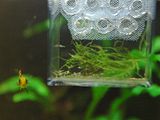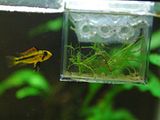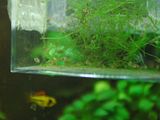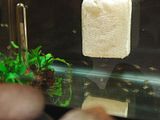Home › Forums › Miscellany › Community › Really sad. Could use some specialized advice from fellow fishkeepers..Happy Update!
- This topic has 14 replies, 1 voice, and was last updated 12 years, 7 months ago by Grayfire_artz.
-
AuthorPosts
-
December 17, 2012 at 5:57 am #505962
(Edit Jan. 27 – new batch is successfully growing up! New post further down.)
Hey all, I have not been in as much as I used to, I miss the forums but work has me so busy with overtime it’s hard to find time for anything. Still lurk a bit. 🙂
In addition to work I’ve been busy raising out a brood of Cockatoo Cichlid fry. They hatched about a month ago and I’ve been raising baby brine shrimp for them, keeping up with the feedings and water changes.
They were growing like weeds and super healthy looking. So much so that they had outgrown the breeder I’ve made. (It hangs in the parent’s aquarium so I can keep an eye on the fry and ensure that they all get enough to eat. The survival rate is much better this way, I’ve found.)
I prepared a grow-out tank for them and moved them. They were all dead within 24 hours. It’s a month of work, quite a bit of money I won’t make selling them, and most of all I LOVE raising them. So to see them die off in a day just crushed me. I was hoping to keep some from this brood for myself. I hand-raised the parents and this was their first successful breeding attempt. I was beyond excited!
The kicker is, I can’t figure out what went wrong. 🙁 Perhaps a few of you might be able to help. Quite a bit of time on google didn’t turn up much specific information.
Here are the parameters: (MEGA information dump, I’m sorry!!!!)
Parent tank: 10-gal
Fry tank: 7-galFry tank filter was seeded with aged filter media from the parent tank to keep the water stable, filled with water from the parent tank, and allowed to cycle for a week before adding the fry. I then did a 25% water change in both tanks as part of my regular maintenance, and tested the water before moving the fry. I use an API Master Test kit.
Temperature 78-79 degrees in both tanks.
Ammonia: 0ppm both tanks
Nitrite: 0ppm both tanks
Nitrate: 5ppm both tanks
pH: Parent tank 7.6, fry tank 7.2Because of the pH difference I drip-acclimated the fry for two hours.
Fry tank is bare-bottom for easy cleaning. I put some driftwood twigs and java moss in for them to hide in though. Moss came from the parent tank. Twigs used to be in the parent tank, had dried out.
Near as I can tell, that’s everything I did right. (I’ve successfully raised 6-7 batches of Apistos with these practices.)
Could the pH difference have done them in, even with a slow acclimation? The fry were not netted or handled and couldn’t have been stressed that way.
There is only one other thing I can think of. The powerhead on my fry filter needs to be taken apart and maintained. It makes a bit more noise than a normal filter. It’s an Aquaclear hang-on for a 20-gallon. I’ve modified the flow so it moves the water extremely gently. I had put my ear right against the glass, to see if the noise levels in the tank might be too much, but it seemed only about 10-15% louder than the parent tank. And that’s a generous estimate.
I put the fry in before going to bed, checked on them 8 hours later when I woke up, and they looked horrible, tail fins narrowed, barely moving, 3 already dead. So I immediately turned off the filter, got oxygen flowing in there with an airstone, and did a 25% water change. They seemed to be slightly better. I ran to the fish store to get some supplies, and when I got back, they were fading fast. By the next morning they were all dead.
Super bummed about this. If any of you have any ideas I’d be really interested. I obviously did something terribly wrong and I want to avoid it in the future. 🙁
December 17, 2012 at 6:30 am #890065As a fellow fish-keeper, I feel your pain. 🙁 I am so sorry you lost your little ones.
I have read over your post….and I can’t see a problem, either. I wouldn’t think the .4 pH difference was significant enough to have killed them like that. The only thing I could think of is that the nitrates were too high even at 5ppm. BUT, you say both tanks test the same. Did they have rapid gill movement?
Next time throw a white cloud or neon in the fry tank as a tester fish. I wish I could help you more. If something percolates in the old noggin during the night or next couple of days I will let you know.
Again, I am really sorry. 🙁
December 17, 2012 at 7:36 am #890067Aw, thank you. They did look stressed. Fins tucked, not swimming much, breathing heavily. Some of them arched their bodies a bit or laid on their sides on the bottom of the tank. I was removing the goners all day to prevent an ammonia spike.
I am wondering if that is what did them in. While I was cleaning the powerhead on the filter I tested the ammonia levels again. It read 1ppm. I was guessing that spike happened overnight as more died, but then I noticed one more dead one in the tank that I’d missed. I’m guessing that might have done it. I doubt he was in there the whole time, I probably just missed one when I took all the dead ones out this morning. I was at my mom’s all day so that would be enough time for him to rot in there. Blugh. Poor little things.
Sponge filter time. Sigh. I feel like the most incompetent fishkeeper ever. They are so fragile. 🙁
There is a silver lining. I also noticed while I was testing the ammonia again and cleaning the filter, that Mama has already laid a new batch of eggs. I am not gonna mess it up this time.
December 17, 2012 at 12:45 pm #890068I’m so sorry! I know zilch in fish-keeping… all I can say, I hope everything goes well this time 🙁
Read my books! Volume 1 and 2 of A Dragon Medley are available now.
http://www.sarahjestin.com/mybooks.htm
I host the feedback lists, which are maintained by drag0nfeathers.
http://www.sarahjestin.com/feedbacklists.htmDecember 17, 2012 at 8:14 pm #890080Fins tucked, not swimming much, breathing heavily. Some of them arched their bodies a bit or laid on their sides on the bottom of the tank.
………….. Sigh. I feel like the most incompetent fishkeeper ever. They are so fragile. 🙁
There is a silver lining. I also noticed while I was testing the ammonia again and cleaning the filter, that Mama has already laid a new batch of eggs. I am not gonna mess it up this time.
Yes, it does sound like nitrate poisoning….unfortunately. Do not feel incompetent! You hand-fed parents and have a breeding pair!!! Fry are notoriously fragile and it is not uncommon for professional keepers to lose a whole brood.
Keep your chin, up, girlie!!!
Congratulations on the new eggs! Let us know how they progess.
December 18, 2012 at 12:18 am #890096Cichlids can be super sensitive to PH differences. Especially fry. And especially for a lower PH. If it had been a slightly higher PH, I dont think you would have seen a die off like that.
December 18, 2012 at 2:00 am #890102A friend of mine that successfully bred several different kinds of fish from killies to discus would often move the parents to the secondary tank rather then stressing the babies out, perhaps try that?
Oh and I know your pain as well when I lost my first Betta batch I was heartbroken as well.
December 18, 2012 at 5:39 am #890113Thanks for the replies and advice you guys. 🙂 I’m gonna adjust some things for this batch accordingly.
I just don’t know how it could have been Nitrate poisoning if both tanks read identical. Unless I read the tests wrong, but it’s not too hard to read. Wampus might have nailed it I think, if it wasn’t Nitrate or Ammonia. pH shock has similar symptoms. It’s super sucky to have made such a stupid mistake, but I do feel a lot better knowing what might have been likely causes. They are easy enough to adjust for in the future.
I don’t think the OMGIKILLEDMYPRECIOUSBABIESIMAMURDER feeling is going to go away too soon though. 🙁
December 18, 2012 at 1:55 pm #890129If your test kit was accurate (the one you use is great unless it’s old, then the readings start to get weird), then I don’t see a problem. The pH difference really is not enough to kill them especially when you drip acclimated them. I know about sensitive fish– used to breed discus! And given a drip acclimation and the pH difference, I doubt that was your problem. The nitrates were 0 so I don’t see where that was a problem either. When you do everything right, it’s time to start thinking abstractly.
I will share a few anecdotes to show what I mean.
I had a customer that was having her fish die off every time she replaced a filter cartridge. We went back and forth trying to figure this out for a few weeks, testing water (always perfect), worrying about tiny temperature changes (rarely a problem), writing to the filter media company! Everything. Then one day I had the thought to ask her where she stored her filter media. Turns out she stored them in the cardboard box in her pantry– where she also stored clothes drier sheets. The silly thing is that she was careful… they weren’t even on the same shelf or near each other, but the air in the pantry was still and over the the filter media absorbed something from the drier sheet and it killed her fish when she put them in the filter!
She stopped storing them there and the fish stopped dying.Another customer I had, had fish dying on a schedule, once per month. Did water tests, everything was okay, etc. I asked him to be really observant to environmental changes around the time the fish started dying. It took a while but finally he found out his wife was using a cleaning product on a counter that was several feet from the fish tank, but some of the tiny overspray must have gotten into the tank. She never told him because she had no idea, and he never knew she was doing it while he wasn’t home.
While I am not at all suggesting that you have drier sheets or chemicals flying into your tank (!!!), I’m just saying that sometimes you have to think abstractly to figure out the problem. Where were the branches stored while they were dry? etc?
Volunteer mod- I'm here to help! Email me for the best response: nambroth at gmail.com
My art: featherdust.comDecember 21, 2012 at 1:41 am #890282I agree with Jen–there’s something fishy (pun intended) that you’re likely not to catch simply by testing the water. My guess is that the culprit is the driftwood. Depending on where you stored it and how long it took to dry out, it could be contaminated with anything from mold to household cleaners. I really don’t think that the pH is a big enough difference to have stressed them out so badly. Especially since the parents were happy enough to breed and the fry were thriving prior to the transfer–Apistos generally prefer a lower pH (5.5 to 6.8), but many fish can be acclimated to higher pH’s. The only water parameter that might be of significance is GH. Depending on your water and your gravel/media, your GH might be completely different. Apistos are somewhat fragile, but not too terribly so. However, they do prefer low GH. Still, since your parent tank has a higher pH, it’s likely that GH, but not impossible, that GH is the culprit. Your answer might be to put some dried Indian almond leaves or dried oak leaves in the tank (the driftwood will do this eventually, too, assuming that it’s not the problem). They’ll help lower your GH, but they’ll probably also lower your pH, so keep an eye on the pH as you’ll have a less well-buffered water.
December 21, 2012 at 2:40 am #890287+1 more vote that the driftwood is the most likely culprit here. Adding organic matter such as leaves or driftwood lower your GH.
Of course, it could be that the wood was simply exposed to something unfriendly in nature, such as pesticides or other chemical agents. However…I’m still leaning towards gh variance as the issue.
I’d just pull the driftwood out. It’s easier to keep consistent water quality across multiple tanks when not dealing with factors like gh altering driftwood.
Many storebought fish are acclimated to water that hasnt been softened with driftwood, leaves or peat. It’s a ton of headache to attempt balancing your ph and gh when most of the time fish deal ok with tap water gh. Especially when you’re dealing with fish transfers between tanks.
Unless you’re diehard about keeping that wood in there, or are dealing with aquatic life that absolutely demands low gh (such as crystal shrimp) it’s truly not worth the headache.
Maintain your water quality, and consistent ph…then just avoid gh altering components in tank decorating in the future. Go with live plants instead, they’ll look pretty and help improve water quality while not altering it in any harmful way.
Try hornwort…it floats, has bushy foxtail plumes and grows like mad. Great hiding place for fry to shelter too.
January 27, 2013 at 10:56 pm #892373Thanks again all for the fantastic advice! I took the driftwood out and haven’t had any problems with momma’s new batch of fry. Whether it was a chemical agent on the driftwood or the driftwood itself causing a GH change, looks like it was the cuplrit for sure.
Now the new fry are doing great. 🙂 Here’s some photos of their progress.
3 Days
7 Days
21 Days
31 Days (as of Jan 20) – doing well in their bigger tank!
🙂
January 28, 2013 at 12:24 am #892377Yay! I love Apistos. I wish I had the patience to raise some.
January 28, 2013 at 12:40 am #892379Aw, they look beautiful, Congrats! 😀
January 28, 2013 at 7:08 am #892391CONGRATS!!! 😀
-
AuthorPosts
- You must be logged in to reply to this topic.




